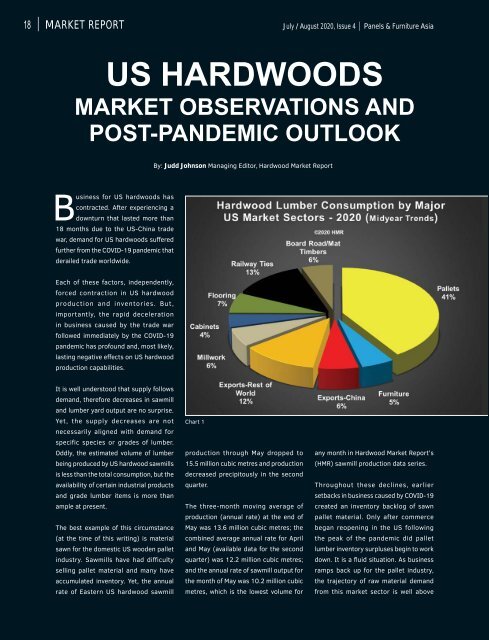Panels & Furniture Asia July/August 2020
Panels & Furniture Asia (PFA) is a leading regional trade magazine dedicated to the woodbased panel, furniture and flooring processing industry. Published bi-monthly since 2000, PFA delivers authentic journalism to cover the latest news, technology, machinery, projects, products and trade events throughout the sector. With a hardcopy and digital readership comprising manufacturers, designers and specifiers, among others, PFA is the platform of choice for connecting brands across the global woodworking landscape.
Panels & Furniture Asia (PFA) is a leading regional trade magazine dedicated to the woodbased panel, furniture and flooring processing industry. Published bi-monthly since 2000, PFA delivers authentic journalism to cover the latest news, technology, machinery, projects, products and trade events throughout the sector. With a hardcopy and digital readership comprising manufacturers, designers and specifiers, among others, PFA is the platform of choice for connecting brands across the global woodworking landscape.
- No tags were found...
Create successful ePaper yourself
Turn your PDF publications into a flip-book with our unique Google optimized e-Paper software.
18 | MARKET REPORT<br />
<strong>July</strong> / <strong>August</strong> <strong>2020</strong>, Issue 4 | <strong>Panels</strong> & <strong>Furniture</strong> <strong>Asia</strong><br />
US HARDWOODS<br />
MARKET OBSERVATIONS AND<br />
POST-PANDEMIC OUTLOOK<br />
By: Judd Johnson Managing Editor, Hardwood Market Report<br />
Business for US hardwoods has<br />
contracted. After experiencing a<br />
downturn that lasted more than<br />
18 months due to the US-China trade<br />
war, demand for US hardwoods suffered<br />
further from the COVID-19 pandemic that<br />
derailed trade worldwide.<br />
Each of these factors, independently,<br />
forced contraction in US hardwood<br />
production and inventories. But,<br />
importantly, the rapid deceleration<br />
in business caused by the trade war<br />
followed immediately by the COVID-19<br />
pandemic has profound and, most likely,<br />
lasting negative effects on US hardwood<br />
production capabilities.<br />
It is well understood that supply follows<br />
demand, therefore decreases in sawmill<br />
and lumber yard output are no surprise.<br />
Yet, the supply decreases are not<br />
necessarily aligned with demand for<br />
specific species or grades of lumber.<br />
Oddly, the estimated volume of lumber<br />
being produced by US hardwood sawmills<br />
is less than the total consumption, but the<br />
availability of certain industrial products<br />
and grade lumber items is more than<br />
ample at present.<br />
The best example of this circumstance<br />
(at the time of this writing) is material<br />
sawn for the domestic US wooden pallet<br />
industry. Sawmills have had difficulty<br />
selling pallet material and many have<br />
accumulated inventory. Yet, the annual<br />
rate of Eastern US hardwood sawmill<br />
Chart 1<br />
production through May dropped to<br />
15.5 million cubic metres and production<br />
decreased precipitously in the second<br />
quarter.<br />
The three-month moving average of<br />
production (annual rate) at the end of<br />
May was 13.6 million cubic metres; the<br />
combined average annual rate for April<br />
and May (available data for the second<br />
quarter) was 12.2 million cubic metres;<br />
and the annual rate of sawmill output for<br />
the month of May was 10.2 million cubic<br />
metres, which is the lowest volume for<br />
any month in Hardwood Market Report’s<br />
(HMR) sawmill production data series.<br />
Throughout these declines, earlier<br />
setbacks in business caused by COVID-19<br />
created an inventory backlog of sawn<br />
pallet material. Only after commerce<br />
began reopening in the US following<br />
the peak of the pandemic did pallet<br />
lumber inventory surpluses begin to work<br />
down. It is a fluid situation. As business<br />
ramps back up for the pallet industry,<br />
the trajectory of raw material demand<br />
from this market sector is well above


















